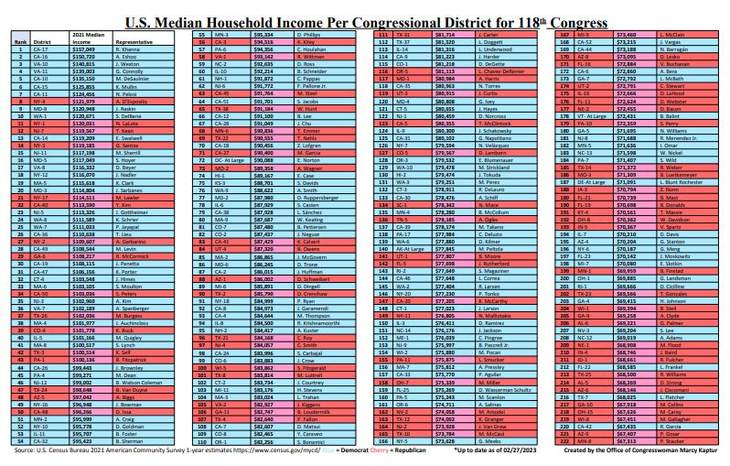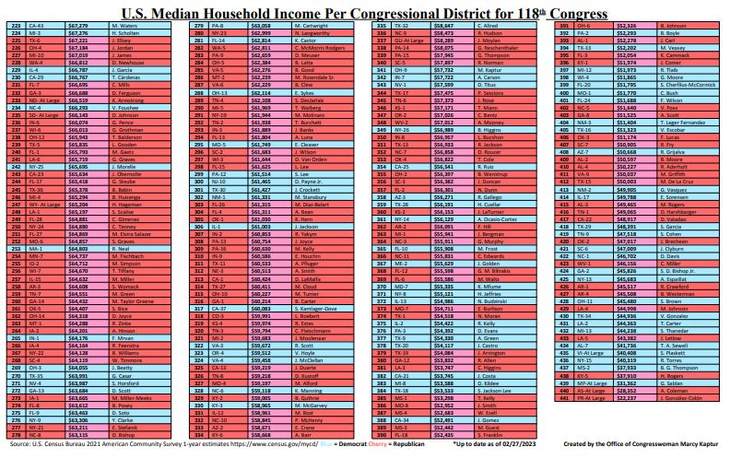This story comes from Rep. Marcy Kaptur of Ohio via Insider. Rep. Kaptur put together a list of every congressional district in the country ranked by median income. The list is just two pages long. Districts that elected Democrats were color-coded blue. Those that elected Republicans were red. And the results were pretty obvious. Page one of the list had a lot of blue and page two had a lot more red. Here’s what it looks like from afar.


If you want to look at the details, Insider has posted a version of the chart here. Axios has taken a look an highlights one of the most obvious points about the very top of the chart.
Nine of the top 10 wealthiest congressional districts are represented by Democrats, while Republicans now represent most of the poorer half of the country, according to median income data provided by Rep. Marcy Kaptur’s (D-Ohio) office…
“Republicans were the party of the country club, and they’re increasingly the party of country,” lobbyist and political analyst Bruce Mehlman told Axios.
“We have seen an inversion of Democrat and Republican shares of the highest- and lowest-income districts — and the highest and lowest college degree-holding districts,” Cook Political Report’s Dave Wasserman told Axios.
There are definitely a lot more blue districts on that first page. Not only are Democrats 9 of the top 10, they are:
- 16 of the top 20
- 34 of the top 50
- 69 of the top 100
One thing that doesn’t get mentioned is that if you look at the very bottom of the list, say the bottom 20 districts on the list, Democrats represent 13 of them. So Dems still have a slight edge at the very bottom of the median income but not nearly as dramatic as the advantage they have at the top.
Rep. Kaptur has been showing the chart to her Democratic colleagues and she says they often get very quiet.
“There’s an elitism that pervades when you have wealth,” she added.
Kaptur has given a version of the chart to President Joe Biden, and says she presented the document to members at a recent caucus meeting. According to her, Democrats ranging from House Minority Leader Hakeem Jeffries down to rank-and-file lawmakers are often taken aback by the visual.
“And then they’re quiet, and they just study it,” she said. “I don’t know where it takes us, except I hope to a more enlightened future.”
They’ve become the party of the elite or at least of the successful upper middle class. What does this do to all of their past rhetoric about the 99%, income disparity and wealth inequality? Do they still care about those things now that their voters appear to be the ones benefitting?
There is a caveat here. Just because Democrats represent top earning districts doesn’t mean that all of the wealthy people in those districts voted for Democrats. Insider points to some 2020 exit polling which seems to show that Biden won among voters making less than $100,000. Trump won among those making between $100,000 and $200,000 and those making above $200,000 were evenly split.
So the picture gets more complicated the closer you look. It may be that even in districts with high median incomes team blue does slightly better among those who are below the median while team red does slightly better with those above the median. Still, Democrats clearly have a significant edge in those top 100 districts (nearly 70%), enough so that the more successful Republican leaning voters are overwhelmed in most cases.
It’ll be interesting to see how Democrats market themselves in light of this information. They were always the party of the downtrodden and those in need of government help. Now they seem to be the party of the better off. This is so contrary to their self-conception that I’m not surprised many of them react to Rep. Kaptur’s list by going silent.








Join the conversation as a VIP Member